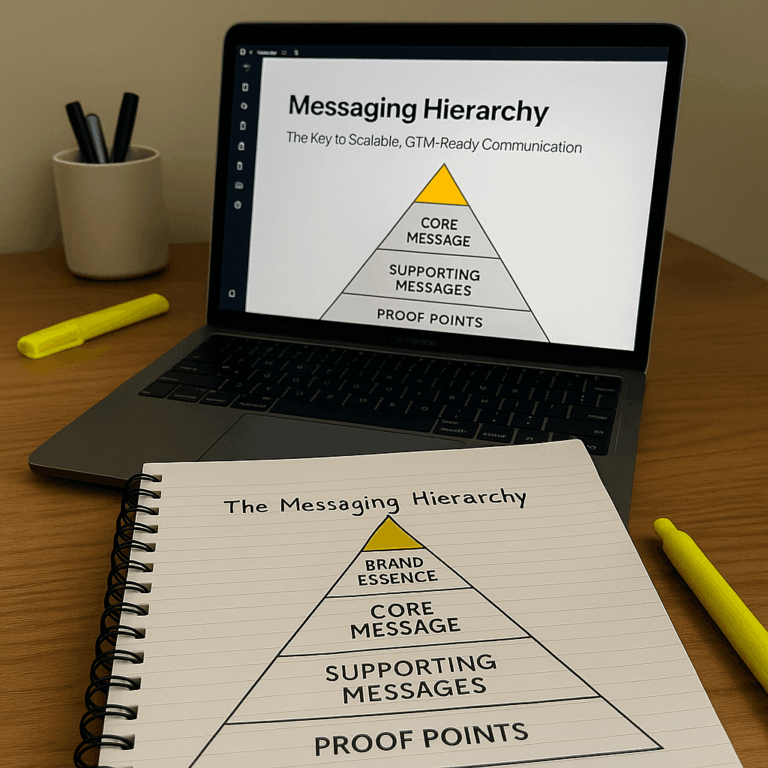Why Brand Messaging Fails at Launch — and How to Fix It

- 1. What Is Brand Messaging — and Why It Matters
- 2. The Cost of Misaligned Messaging
- 3. Signs Your Brand Messaging Strategy Is Failing
- 4. Why Go-to-Market Messaging Breaks Down
- 5. Building an Effective Brand Messaging Framework Before Launch
- 6. Align Messaging With TAM, SAM, SOM
- 7. Fixing a Weak Campaign After Launch
- 8. Long-Term Brand Messaging Consistency
- 9. Examples of Brand Messaging That Works
- 10. Supercharge Your Launch With Strong Brand Messaging
Most launch failures trace back to one root problem: brand messaging that doesn’t connect. Teams build brand messaging frameworks, polish marketing strategies, and develop brand message templates — yet weeks after launch, prospects are still asking what you do. Conversion rates stay flat, even when reach and awareness look strong.
This disconnect between a brand message and customer perception is common in today’s crowded digital space. Whether you’re introducing a new product, entering a market, or relaunching a brand, weak messaging can derail growth before it starts.
What Is Brand Messaging — and Why It Matters
At its core, brand messaging is how you communicate your brand’s value, story, and positioning to the market. A strong brand message framework defines:
-
What makes you different (brand positioning)
-
Why customers should trust you (proof points)
-
How your solution improves their lives (brand promise)
Without a consistent brand message strategy, even the best marketing campaigns struggle.
The Cost of Misaligned Messaging
When brand messages don’t land, the damage extends beyond a weak launch:
-
Sales cycles drag on.
-
CAC rises as acquisition gets harder.
-
Inconsistent branding messages erode trust.
-
Competitors capture category ownership while you’re still explaining your value.
Research shows brand recall drives nearly 40% of brand lift in emerging media. If your messaging framework fails to deliver clarity and consistency, you lose that first-mover advantage.
Signs Your Brand Messaging Strategy Is Failing
Here are common signals your brand message isn’t resonating:
-
Prospects keep asking your value proposition → unclear positioning.
-
High traffic but low conversions → attention without connection.
-
Customers use different language than your branding messages → your story misses.
-
Frequent comparisons to unrelated competitors → category isn’t defined.
Why Go-to-Market Messaging Breaks Down
Even strong brand messaging strategies using a phased GTM rollout can collapse when:
-
Teams assume customers share their internal context.
-
Brand messaging guidelines aren’t followed across channels.
-
Content isn’t adapted for platform nuances (sales decks ≠ social ads).
-
Vanity metrics overshadow true message performance.
Building an Effective Brand Messaging Framework Before Launch
Start with customer insight.
Don’t just guess what your brand message should be — validate it with data. Surveys, focus groups, and testing messaging examples reveal what resonates.
Develop a messaging hierarchy.
Strong brand messaging architecture aligns with the buyer journey:
-
Awareness → problem framing + brand positioning
-
Consideration → differentiation + brand pillars
-
Decision → proof points + value proposition clarity
Ensure consistent brand messaging.
Document guidelines so brand messages adapt per channel while staying unified. This prevents the common breakdown between content marketing, paid ads, and sales collateral.
Align Messaging With TAM, SAM, SOM
Even the sharpest narrative fails if aimed too broadly. Market-sizing tools like TAM, SAM, SOM keep storytelling realistic:
-
AM (Total Addressable Market): the full universe of potential buyers
-
SAM (Serviceable Available Market): the audience you can realistically reach
-
SOM (Serviceable Obtainable Market): the portion you can win now
Your messaging should scale with this model: broad, category-defining stories for TAM; targeted value propositions for SAM; and highly specific proof points for SOM. This alignment ensures your message reaches the right audience at the right time.
Fixing a Weak Campaign After Launch
If your messaging campaign is live but underperforming:
-
Audit for inconsistencies across all branded messages.
-
Simplify around one core message instead of scattered themes.
-
Test incremental brand messaging examples and track engagement.
Many companies use a strategic marketing consultancy or a qualitative research company at this stage to realign campaigns and strengthen credibility.
Long-Term Brand Messaging Consistency
The most effective brand messaging strategies evolve with customer needs while protecting the core story. A scalable brand messaging framework supports future campaigns, new products, and market shifts without losing clarity.
Consider this example: fusepoint partnered with a DTC haircare brand struggling with unclear messaging. After surveying 6,500+ customers, the company learned that buyers valued the results of a product over discounts. By pivoting brand messages to focus on efficacy, redesigning materials, and reinforcing brand messaging pillars, the brand improved loyalty and scaled profitably.
The takeaway: brands that win invest in consistent brand messaging — not just more reach.
Examples of Brand Messaging That Works
-
Nike → “Just Do It” (clear, motivational, consistent)
-
Apple → simplicity and innovation at the center of every message
-
DTC haircare brand (case study) → results-focused messaging drove growth
These brand messaging examples prove that clarity beats complexity every time.
Supercharge Your Launch With Strong Brand Messaging
Budgets prioritize where you spend. Messaging prioritizes what you say. Without a defined brand messaging strategy, campaigns risk falling flat.
If you’re ready to sharpen your story, fusepoint’s customer insight services can help. From building brand messaging frameworks to optimizing live campaigns, we ensure your message resonates, converts, and scales.
Our Editorial Standards
Reviewed for Accuracy
Every piece is fact-checked for precision.
Up-to-Date Research
We reflect the latest trends and insights.
Credible References
Backed by trusted industry sources.
Actionable & Insight-Driven
Strategic takeaways for real results.










